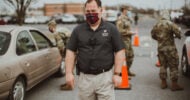“Thank God you’re still here, Doc! It looks like they already laid off half the pharmacy department! The line is out the door!”
“Don’t worry, Mr. Golati! It’s just a regular day at the VA!” I replied.
October 1st at the VA Hospital was like every other day in most ways. It was still hard to find a parking space in the far-too-small lot. The hallways still bustled with white coats, smiling vets, and the smell of just-smoked cigarettes. Veterans Affairs hospitals continue to be fully funded, despite the shutdown of the federal government. Still, the veterans appear to have picked up on subtle changes (and the threat of more change), and things are a bit different.
Mr. Golati was right. The line for the pharmacy was longer than usual, as were the lines for flu shots, blood draws, and haircuts. The call center filled the slots for urgent visits, but some vets came without appointments just to check on us.
“Oh, good! Just checking to make sure you were still here,” one vet said as he walked by the door of the pharmacist in one primary care firm.
“Well, I felt the start of an infection coming on, so I thought I better not wait before dropping in. You know, in case it’s too late,” another vet commented at the start of his drop-in appointment.
The VA directed people to their “Veterans Field Guide to the Government Shut Down.” Many vets read this, or heard a summary on the news that blared in the waiting rooms. It lists things not affected by the shutdown: VA hospitals, clinics and many national hotlines. There is also a list of things affected (or soon to be affected) by the shutdown: most notably contact, processing, and eventually payments from the Veteran Benefits Administration.
“Do they really want a bunch of angry veterans running around without their checks? Not paying our mortgages? Not buying food?” one veteran asked. He said he depends on his check, month to month, and has no contingency plan for even one missed payment.
This anger was palpable in the waiting rooms and hallways.
“They keep getting paid, huh? Assholes.”
“Those people sent me to war, and they can’t even get along for this one stupid thing? They’re really hurting people, you know.”
My second patient of the day, Mr. Johnson, was living in an extended care facility, and had not heard about the shutdown.
“Shutdown? I don’t know anything about that, but I can tell you joke if you want! Spell pig backwards and then say funny!”
I really love the VA.
The clinical staff, despite being a little busier than usual, was in good spirits.
“I’m already a half hour behind, and I can’t get this article to print!”
“You didn’t get the memo? That printer is on furlough.”
Clinical care continued as usual, but every patient I encountered that day had something to say about the shutdown. I struggled with how to respond to my patients’ concerns. I tried to reassure them that the hospital and clinics would still be here, and nothing would change. But that wasn’t really true. Just one day into the shutdown, and things had already changed. The veterans, the men and women who are heroes to all of us, were to some degree afraid. They filled the clinics and pharmacies, because just the thought of a shutdown of these services was cause for alarm. They wait as the days go by, and they don’t know if or how to plan for a late benefits check. Their elected officials leave them in a state of uncertainty. The military and the VA are built on rules, regulations, and order. So, to all of us, this is frightening.
As the shutdown carries on, things really are mostly the same. Parking lots are full. Veterans still get the medical care they need. We worry about them; they worry about us. We both worry about how long it will take the federal government to put people over politics.
Megan S. Lemay is an internal medicine resident.













![Preventing physician burnout before it begins in med school [PODCAST]](https://kevinmd.com/wp-content/uploads/The-Podcast-by-KevinMD-WideScreen-3000-px-4-190x100.jpg)


![Why high-quality embryos sometimes fail to implant [PODCAST]](https://kevinmd.com/wp-content/uploads/Design-3-190x100.jpg)

